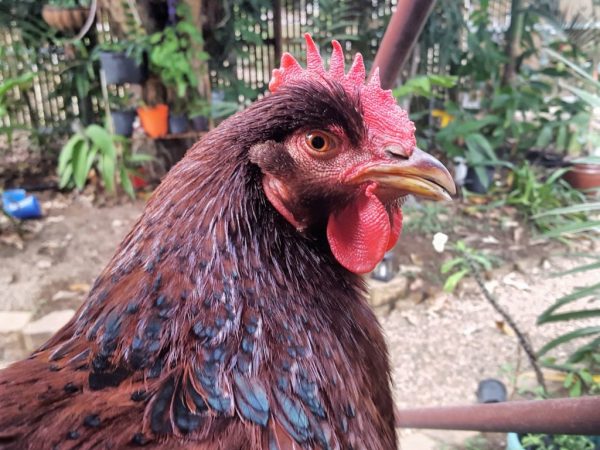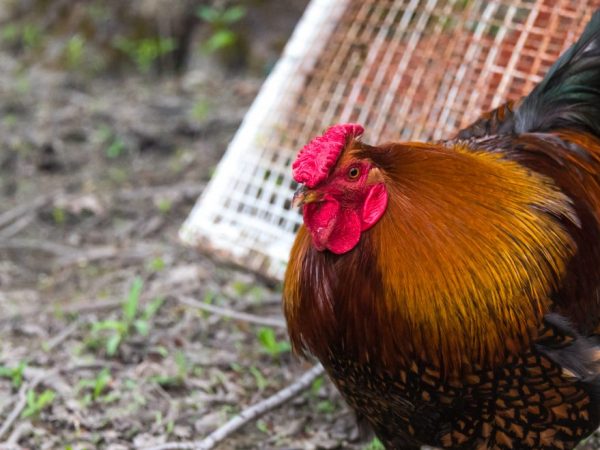Rhode Island Chickens
The breed of chickens of the genus Island was brought to Russia in the early 1900s. The history of its origin begins in 1854. After 100 years, she was awarded the title of the official bird of the state of Rhode Island. The breeding turned out to be successful, thanks to which they were included in the standard of excellence and often participate in exhibitions.
- Brief information about the breed
- Description of the breed
- The cost
- Appearance
- Character
- Survival instinct
- Productivity
- Advantages and disadvantages
- Breeding features
- Incubation
- Chicks feeding
- Chick care
- Keeping adults
- What should be a chicken coop
- Food
- Place for walking
- Molt and break of egg production
- Possible diseases
- Owner reviews

Rhode Island Chickens
Brief information about the breed
- Productivity type: meat and egg.
- Rooster weight: heavy (3.5 kg).
- Chicken weight: medium (3 kg).
- Ovipositor start: medium (at 6.5 months).
- Egg production: average, 180-200 pcs per year.
- Features of the: unpretentious to conditions of detention, resistance to diseases and good immunity, weak maternal instinct.
- Egg sizes: medium (55-60 g).
- Are they suitable for a beginner: Yes.
Description of the breed
When creating this breed, Corniches and Wyandots took part as additional material. The resulting hens have reddish-brown plumage and dark, rich shades.
The cost
It is grown mainly in private farms. The cost is:
- 50-90 rubles - one hatching egg;
- 100-200 - chicken;
- 1500 - 2500 - adult chicken.
There is no mass breeding in large poultry farms, but representatives of the breed are kept as a genetic reserve for further breeding.
Appearance
Feathers are dense, inherited from Malay and Javanese birds.
The body is motley, brown in color, in some it is brighter, in others it is lighter, closer to red. There may be several black feathers in the tail and wings. Earrings, crest and ears are red, eyes, skin on legs and beak are yellowish.
Males usually weigh about 4 kg, but chickens weigh less - up to 3 kg.
Character
Rhode Island chickens are curious, active and friendly. Quiet behavior is unusual. Walking is required. During it, they try to find food for themselves. It is possible to live in a paddock.
There is no fear of people, the attention of the owner is important to them. Males tend to behave more aggressively, so sometimes more caution is required when interacting.
Chickens almost never become chickens. Despite diligence in hatching and protecting the young, the maternal instinct is suppressed. Therefore, it is better to use an incubator or hen.
Survival instinct
Cubs and adults are in very good health, resulting in a 70-80% survival rate.
Productivity
Egg production rates are average. Usually 2 layers lay up to 185 eggs. Perhaps up to 220, if the owner takes care of the correct maintenance and a complete diet of individuals.
Almost every egg can be used for incubation because fertilized.
Advantages and disadvantages

The breed is friendly to humans
Beginners can note the following benefits of chickens:
- unpretentious content;
- friendly behavior towards people;
- optimal performance indicators;
- strong immunity.
Disadvantages can also be noted:
- weak expression of maternal instinct.
- short egg production, layers retain productive qualities only for about 2 years.
Breeding features
The keeping rules depend on the age and health of the birds. Chicks that have recently hatched need special treatment to develop and maintain good immunity.
Pay attention to chickens during the incubation period when they are laying eggs.
Incubation
Chickens can lay for up to six months. There are no long breaks.
During the incubation period, it is important to create ideal living conditions and take care of good nutrition.
Chicks feeding
In the first few days, it is advisable to include millet, wheat, barley, corn porridge with the addition of onions, dill and nettles in the diet.
Sometimes herbs, boiled eggs and grated vegetables (including beets and potatoes) are added. It is imperative to monitor the freshness of the diet, because the digestive tract of young animals is poorly developed. Only fresh boiled water can be used as a drink.
After a couple of weeks, you can give dry cereals and gradually transfer to plain water. The transition to adult food should be gradual.
Chick care
In the first few days, it is advisable that the young are in safe arenas. Bottles and heating pads with warm water or electrical appliances are traditionally used for heating.
Initially, the room temperature should be 30 °. Then it is gradually reduced by 2 ° every week. Proper care of chicks will protect them from various diseases.
Maintenance of adults
Breeders need to take care of the presence of a large chicken coop and a properly landscaped area. There should be a good walking area and a complete and balanced food.
What should be a chicken coop
The chicken coop must be large, it must be insulated.

It is important to arrange the territory for birds correctly.
Straw or wood sawdust is used for laying the floor, and it must be regularly changed in the warm season, and in the cold season - topped up.
In the spring, the compost that formed during the winter can be used as fertilizer for the vegetable garden, if necessary.
Food
The presence of nutrients in the feed is required. For this reason, you need to take care of a balanced diet.
Typically, the following foods are included in the diet:
- meat and bone or fish dust;
- chalk or crushed shell rock;
- spoiled milk;
- cottage cheese of any fat content;
- fish fat.
You also need to make sure that there is a grain feed. It is advisable to exclude corn as the line in question is prone to obesity. To preserve the quality of meat and eggs, avoid mash, cooked with boiled potatoes.
Cereal mixtures are prepared independently or they buy special feed, taking into account the age category of individuals.
Place for walking
There is an increased activity of birds, so regular walking is required. Care must be taken to ensure that they can independently obtain food, incl. greens.
Molt and break of egg production
Chickens lay eggs at any time of the year, even in winter; they lay eggs, showing weak maternal instincts.
The molting period is short, therefore, female individuals need care, despite their adaptability to various living conditions.
Possible diseases
Rhode Island has good immunity. Illness usually develops due to poor care or malnutrition.
Signs of the disease: chickens are disheveled, indifferent to food, have a dull look and plumage, sleep while standing. It is advisable to keep the sick individual separately from the rest in order to prevent infection.
In most cases, the following ailments appear:
- atony;
- lice;
- ticks;
- cannibalism;
- inflammation of the cloaca;
- bowel disease;
- chewing lice;
- smallpox;
- paralysis;
- coccidiosis;
- pullorosis typhoid;
- cholera.
The main prevention is a varied diet with high-quality feed, creating good conditions in the poultry house, regularly cleaning the cages and disinfecting, observing the temperature and humidity of the air.
Owner reviews
Basically, breeders leave positive feedback on the Rhode Island breed.
The brood hens lay well and produce large, fertilized eggs. And chicks quickly adapt to different living conditions.


